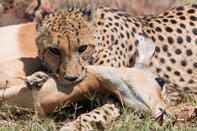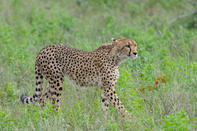Tears and Spots

The cheetah is easily recognized by the presence of two black ‘tear marks’ running down the sides of its nose from the corner of the eyes to the corners of the mouth.
They also have black spots covering the body rather than the rosettes characteristic of leopards. Adult cheetah also have a crest of hair down their backs but this generally lies flat and is only erected when the cheetah wishes to appear larger.
Males in confrontation with other males or individuals threatened by enemies will pilo-erect the longer hair on their backs to accentuate their size and thus appear more formidable or intimidating.
A Predator But Picky

Although they are diurnal predators, i.e. active during the daytime, cheetah still prefer to use the cooler morning and late afternoon hours to hunt and move, resting up in the shade during the hotter parts of the day, somewhere with a view or their surrounds. If it is cold, cheetah like to sun themselves, becoming active later than usual.
Cheetah are picky eaters skimming meat neatly off the surface of a carcass. They may eat the heart and liver but the other innards are discarded. Bones and skin are also discarded due to their toughness and the cheetah’s diminished dentition and small jaws.
They only scavenge occasionally and usually when displacing another predator is not required.
A Genus of Their Own

Cheetah do not roar in the manner of the larger cats and as such are in a genus of their own i.e. Acinonyx vs. Panthera (lion and leopard). They produce various bird-like sounds to keep contact with young or to greet one another.
When content, cheetah are known to purr loudly. Under duress they may growl, snarl, hiss, bleat, cough or moan.
Cheetah regularly make use of elevated vantage points when resting or hunting. They are poor climbers but will take to sloping tree branches or climb atop termite mounds in order to better view their surroundings looking out for prey or enemies like lions.
By Megan Emmett